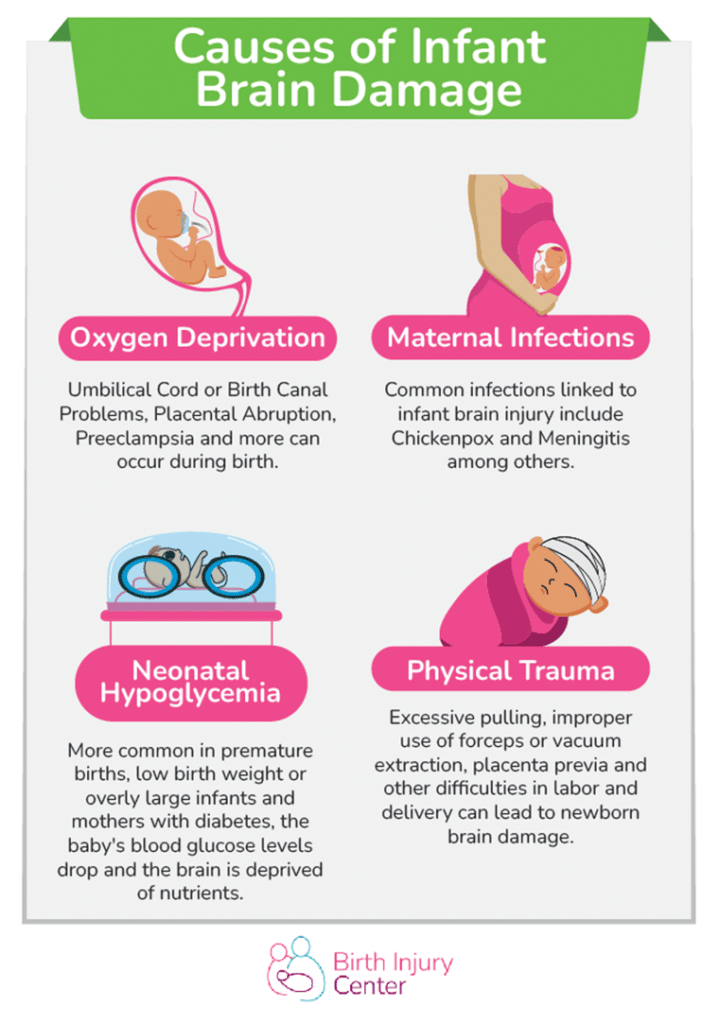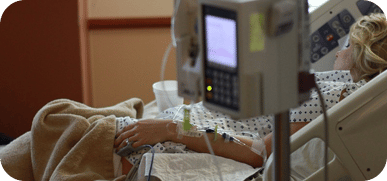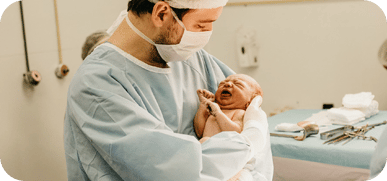Infant Brain Damage
Almost three in 1,000 full-term newborns will suffer some degree of brain damage during the birthing process. Although there are countless causes behind infant brain damage, the outcome is often the same — long-term permanent neurological problems and a wide range of physical issues.
Home > Infant Brain Damage
- Last Updated Date: March 14, 2024
However, what’s even more problematic is that it takes time to diagnose the brain damage in many circumstances, and the unfortunate reality is that your doctor or birthing staff might be responsible. Therefore, to ensure that you take the proper actions after you suspect infant brain damage, it’s important to educate yourself on how infant brain injuries occur, the different types of brain damage your child can suffer, symptoms you need to watch out for, which treatment methods your child might require or benefit from most, and whether legal action is the right choice for your family.

Types of Newborn Brain Damage
Even though newborn brain damage can occur in any part of the brain, it most commonly affects three regions: the cerebral cortex, the cerebellum, and the brainstem. Consequently, the injuries that result from infant brain damage can often affect the child’s intellectual abilities, mood, and even motor skills long-term.
While infants can suffer from numerous types of brain damage before or during birth, some of the most common injuries include:
Hypoxic-ischemic encephalopathy (HIE) is a type of newborn brain damage caused by limited blood flow and oxygen deprivation. Generally, HIE results from various medical complications around the time of the baby’s birth. In many instances, medical malpractice also plays a role.
Children with HIE often experience the following symptoms:
- Feeding difficulties
- Missing reflexes
- Seizures
- Breathing problems
- High or low muscle tone
An intracranial hemorrhage is bleeding inside the skull. As the blood builds up in this closed space, this puts pressure on the brain that can lead to rapid brain damage or death. Symptoms of this condition include:
- Paused breathing
- Decreased muscle tone
- Changes in blood pressure or the heart rate
- Excessive sleep
- Decreased reflexes
- Seizures
Microcephaly refers to a condition where the baby’s head is much smaller than expected. During pregnancy, a baby’s head grows as their brain grows. Consequently, microcephaly occurs when the baby’s brain doesn’t fully develop during pregnancy or stops growing after birth. Not only does this condition result in a smaller head size in infants, but it can also cause the following problems:
- Seizures
- Developmental delays
- Intellectual disabilities
- Problems with movement and balance
- Feeding problems
- Hearing loss
Hydrocephalus is a build-up of fluid in the brain, causing pressure in the skull that can lead to brain damage. Common signs and symptoms of hydrocephalus in infants include:
- An unusually large head
- A bulging or tense soft spot on the top of the head
- Vomiting
- Sleepiness
- Poor eating
- Irritability
- Seizures
- Problems with muscle tone
Caput succedaneum results when there’s swelling of the scalp in a newborn. It typically occurs due to increased pressure from the vaginal wall, uterus, or birthing canal during a head-first delivery. Caput succedaneum doesn’t always lead to brain injury; mild cases are actually very common, and usually resolve on their own. However, more severe cases increase the risk of kernicterus, which can cause brain damage. Caput succedaneum might also indicate significant head trauma during birth, which can also damage the brain; medical professionals should carefully examine the newborn for signs that this occurred. Symptoms of this condition can include:
- Soft, puffy swelling on the scalp
- Color change or bruising of the scalp
- A bulge that extends to both sides of the scalp
Periventricular leukomalacia (PVL) involves damage to a type of brain tissue called white matter, which is located next to the fluid-filled cavities of the brain. It often results because the brain tissue has died or experienced serious injury. For instance, PVL can happen if there’s a lack of blood flow to the brain before, during, or after birth. PVL is an irreversible birth injury to the brain, making it very important for parents to seek the right treatment plan for their child. The life expectancy of the condition depends on the severity of the child’s symptoms, meaning there is no clear answer.
One of the more common symptoms of PVL is spastic diplegia, which is a form of cerebral palsy that leads to tight and contracted muscles, especially in the legs.
Cerebral palsy (CP) refers to a group of disorders that affect an individual’s ability to maintain balance, posture, and movement. CP is the most common motor disability in childhood. Its cause is often the result of abnormal brain development or damage to the developing brain that affects an individual’s ability to control their muscles. In some cases, CP is caused by oxygen deprivation during birth.
Those with CP may experience a variety of different symptoms, including:
- Issues with posture and movement
- Seizures
- Hearing, vision, and speech problems
- Changes in the spine
- Joint problems
- Intellectual Disabilities

Causes of Infant Brain Damage
The causes of infant brain damage can be wide-ranging. Still, specific contributing factors often lead to such injuries, sometimes caused by doctor or hospital staff negligence before or during your child’s birth. Common causes of infant brain damage include:
Medical Conditions in the Mother
Medical Conditions in the Mother
A mother might suffer several medical conditions or illnesses during pregnancy that can affect her developing child and potentially result in infant brain damage, especially if not treated appropriately.
Preeclampsia is a pregnancy complication characterized by high blood pressure. This condition can cause a disturbance in the blood supply to the baby’s brain. If the baby doesn’t get enough oxygen and nutrients, its brain cells will start to die, causing significant brain damage.
Gestational diabetes is a type of diabetes that isn’t present in the mother until after she becomes pregnant. Gestational diabetes can result in a large baby both in length and birth weight, high blood pressure (preeclampsia), and low blood sugar (hypoglycemia) in both the mother and the fetus when treating the illness with insulin. A larger baby can result in difficult labor and delivery or a C-section, increasing the risk of brain and other birth injuries.
Certain preexisting maternal medical conditions can also put the unborn child at greater risk of a brain injury or complicated labor and delivery, leading to birth injuries. The following illnesses can affect your pregnancy and birth when not identified and properly maintained:
- Epilepsy
- Irritable bowel syndrome (IBS)
- Metabolic disorders
- Certain genetic conditions
- Asthma
- Obesity
- Vitamin deficiencies
- Certain hormone problems, including thyroid issues
Asphyxiation
Asphyxiation
Asphyxiation, or lack of oxygen, can frequently cause infant brain damage, especially when the baby loses oxygen before and during birth. This can occur because of placental separation from the uterine wall (known as abruption), a lengthy birthing process, umbilical cord issues, or meconium aspiration syndrome.”
Infections
Infections
Viral or bacterial infections can affect both the mother and her fetus or infect the child during delivery. These illnesses can either impact brain development or cause damaging and life-threatening impacts for newborns whose immune systems have not developed fully. Some dangerous infections during pregnancy and delivery include:
- Zika virus, contracted through bites from infected mosquitoes
- Genital herpes, a sexually transmitted infection (STI)
- Rubella or German measles
- Syphilis, a sexually transmitted infection (STI)
- Cytomegalovirus, a virus from bodily fluids
- Urinary tract infections (UTIs)
- Yeast infections
- Hepatitis, affecting the liver and having various causes, including sexual transmission
- Toxoplasmosis, caused by a parasite if you come into contact with infected cat waste, contaminated raw meat, or infected blood transfusions
- Group B strep (GBS), causing blood infections, pneumonia, and meningitis in newborns
- Bacterial vaginosis (BV)
Head Trauma
Head Trauma
Head trauma, sometimes resulting in brain injury, can happen when physical force from the outside puts pressure on the newborn’s head. Labor dystocia, or prolonged or complicated labor and delivery, can increase an infant’s risk of head injuries throughout the birthing process. Trying to manipulate the baby’s position or speed up pushing using different birthing tools or manual techniques can affect the skull, scalp, or facial areas of an infant.
Injuries can range from lacerations to fractures and can be mild and easily treatable or severe and cause long-term or permanent damage, including brain damage, or even death due to the fragile nature of a baby’s head
Jaundice or Kernicterus
Jaundice or Kernicterus
Immediately after birth, some babies’ livers have trouble filtering out bilirubin, a yellowish substance produced during the normal breakdown of red blood cells. The rise in bilirubin levels causes jaundice, which is apparent as a yellowing of the skin and the whites of the eyes. When it goes untreated, it can cause a condition called kernicterus, which is a type of brain damage resulting from high levels of bilirubin in the baby’s blood. Kernicterus can lead to athetoid cerebral palsy, hearing loss, vision loss, teeth problems, and intellectual disabilities.
Premature babies are at a greater risk for jaundice and accompanying complications, so it’s important that your infant, especially those born early or having other health problems, receive prompt treatment.
Prevention of Newborn Brain Damage
Preventing brain damage in newborns starts with high-quality health care during both the pregnancy and the birthing process. Care providers should:

Carefully monitor the mother and her baby throughout the pregnancy, using ultrasounds, blood tests, and other imaging.

Use interventions when necessary to protect the health of the mother and her baby.

Avoid unnecessary interventions to the birthing process.

Schedule planned C-sections for mothers with certain infections, complications, or conditions like gestational diabetes or preeclampsia.

Carefully hold and move your baby only as it’s necessary.
While not all newborn brain injuries are preventable, careful attention from your physician and other health care providers can significantly affect infant outcomes. You should stay connected with your health care team to keep your overall health throughout your pregnancy a top priority. Don’t shy away from asking questions and taking charge of your and your baby’s health needs. Additionally, ensure you follow your physician and health care team’s advice, recommendations, and directives so that your pregnancy and child’s birth are as seamless as possible, barring negligence or wrongdoing on the part of your physician and hospital or birthing center staff.
Immediate Signs of Brain Damage at Birth
Infant brain damage is not always easily recognized. Sometimes symptoms can be mild or delayed. However, in many cases, there are certain symptoms that you can watch for that might indicate your child suffered a brain injury at birth. These signs can be both physical and cognitive and include:
Physical Signs of Infant Brain Damage
The physical signs of infant brain injury or damage include:
- Head or skull that doesn’t seem to be the right size compared to the rest of the infant’s body (either too large or too small)
- Apparent swelling or bruising around the head
- Abnormal eye movements
- Seizures
- Low muscle tone
- Inability to sleep lying down
- Feeding problems
Cognitive or Developmental Signs of Infant Brain Damage
In some cases, you might not see immediate physical symptoms of infant brain injury or damage. However, as your baby grows, you might begin to notice cognitive or other developmental delays, including:
- Failure to meet milestones, such as rolling over, sitting up, or babbling
- Limp neck or an infant who cannot lift its head by six months
- Involuntary movements
- Difficulty speaking
- Short attention or memory span
- Lack of curiosity or interest in the environment or surroundings
- Trouble understanding social rules or behavioral consequences
- Lack of self-help skills or difficulty adapting to age-appropriate self-awareness
- Infantile behavior that persists despite age
- Lack of problem-solving or reasoning skills or difficulty thinking logically
Treatment Options For Infants With Brain Damage
Infant brain damage is not always easily recognized. Sometimes symptoms can be mild or delayed. However, in many cases, there are certain symptoms that you can watch for that might indicate your child suffered a brain injury at birth. These signs can be both physical and cognitive and include:

Medication designed to help with seizures or specific abnormalities

Physical therapy

Occupational therapy

Behavioral therapy

Cooling therapy

Surgery to help relieve pressure on the brain
Long-Term Care for Brain Damage Birth Injuries
You might have a long road ahead if your child experienced a brain injury at birth. Your child’s specific condition, including the type of brain damage, its severity, and the instances surrounding their injury, usually influences the prognosis. Your child’s doctor can give you a better idea of what to expect as your child grows, including their overall outlook, long-term goals, and the quality of life you can expect for your child.
No matter your infant’s prognosis, there are helpful resources and information that can provide support to you and your family. You can connect with other parents and experts, learn about your child’s brain injury and current research and treatment options, know what to expect, find support groups and financial guidance, apply for benefits, and more.
Check out the national resources or talk to your doctor about the options available in your local area and how they can help you devise a higher standard of care for your child while maintaining your own mental health and wellness as your child’s caregiver and advocate.
The Cost and Burden of Infant Brain Damage
Infant brain damage can place a considerable financial burden on your family. In addition to the costs of medical treatment, your infant might need around-the-clock care. For many parents, that means leaving a career to become a full-time caregiver or hiring specialized help, often a certified nursing assistant (CNA) or team of health care professionals, to properly care for your child.
Many parents of brain-damaged infants feel isolated as they struggle to care for their child. Also, you might have ongoing medical, rehabilitation, or physical therapy bills to manage, sometimes for the rest of your child’s life, meaning extending beyond the age of adulthood.
Some families might qualify for Supplemental Security Income (SSI) or a type of government assistance allocated to individuals with disabilities having little to no income. Additionally, if your child’s birth injury resulting in short- or long-term brain damage was due to physician or hospital staff negligence or wrongdoing, you might have legal recourse to recoup some of your financial harm stemming from the preventable injury.
Written by:
Birth Injury Center Team
The Birth Injury Center aims to create informational web content and guides to help women and their families seeking support and guidance for birth injuries caused by medical negligence. All of the content published across The Birth Injury Center website has been thoroughly investigated and approved by medical expert Natalie Speer, RNC-OB, Attorney Ryan Mahoney.


